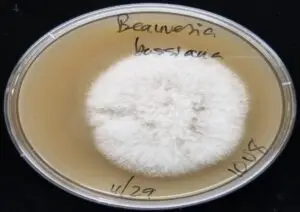Introduction
Researchers use Sabouraud Dextrose Agar (SDA) to isolate, cultivate, and keep both non-pathogenic and pathogenic types of fungus and yeast. Sabouraud developed it in 1892 for the propagation of dermatophytes. The pH is adjusted to roughly 5. 6 to encourage fungal development, particularly dermatophytes, and somewhat reduce bacterial development in clinical specimens.
Principle
Peptone (Enzymatic Digest of Casein and Animal Tissue) supplies the nitrogen and vitamin source necessary for microbe development in Sabouraud Dextrose Agar (SDA). Dextrose is included as the energy and carbon source. Agar serves as the solidifying ingredient.
Researchers may use chloramphenicol and/or tetracycline as broad-spectrum antibiotics to suppress the proliferation of a variety of gram-positive and gram-negative microorganisms.
They add gentamicin to help prevent the development of gram-negative bacteria. The neutral pH of the Emmons modification appears to encourage the development of several pathogenic fungi, including dermatophytes.
Composition
| Ingredients | Amount (gm/1000ml) | Functions |
| Dextrose | 40 | Carbon and energy source |
| Peptone | 10 | Provides nitrogen, vitamins, and amino acids |
| Agar | 15-20 | Solidifying agent |
| Distilled water | 1000 ml | Solvent |
Optional additives
Chloramphenicol (0.05g):- Inhibits bacterial growth in clinical/mycology use.
Cycloheximide (0.5g):- Inhibits saprophytic fungi (not always used).
Preparation
- Dissolve 65g SDA in 1000 mL of water, and then add a pinch of chloramphenicol to the agar.
- Before autoclaving at 121 degrees Celsius and 15 psi.
- Allow the solution to cool before pouring it into sterile Petri-plates.
Example of microorganisms
Microorganisms that commonly grow on (SDA) include Saccharomyces cerevisiae, Aspergillus niger, Candida albicans, Trichoderma viride, Verticillium lecanii, and Beauveria bassiana.
SDA provides a nutrient-rich environment, particularly suited for the cultivation of fungi and yeasts due to its slightly acidic pH and high dextrose content
Colony appearance on Sabouraud Dextrose Agar
| Organism | Morphology |
| Saccharomyces cerevisiae | Creamy, smooth, moist, opaque colonies |
| Aspergillus niger | Initially white, turning black with conidia; granular or powdery texture |
| Candida albicans | Creamy, smooth, glistening colonies; off-white to cream |
| Trichoderma viridae | Rapid-growing, greenish colonies |
| Verticillium lecanii | White to yellowish, cottony or powdery colonies; moderate growth |
| Beauveria bassiana | White, velvety to powdery colonies; may turn pale yellowish with age |
Uses of Sabouraud Dextrose Agar
- (SDA) is used to separate and grow fungi, mainly yeasts and molds.
- Commonly used in clinical, pharmaceutical, cosmetic, and food microbiology.
- Aids in the enumeration of fungal pollutants in environmental samples.
- Used to cultivate dermatophytes, Candida spp., Aspergillus spp., and other fungi.
- It helps detect fungal contamination in industrial products.
- Worked in research labs conducting fungal morphology studies.
Precautions of Sabouraud Dextrose Agar
- To prevent contamination while handling, keep sterile.
- Do not overheat (SDA) while processing to keep medium quality.
- Before sterilization, modify and verify the pH (5. 6 ± 0. 2).
- Sterilize at 121°C for 15 minutes under 15 psi pressure.
- If taking antibiotics (such as chloramphenicol), add after cooling to roughly 45–50°C.
- Keep prepared dishes at 2–8°C, away from light and moisture.
Limitations of Sabouraud Dextrose Agar
- Due to its low pH and restricted nutrition of Sabouraud Dextrose Agar, it is unsuitable for fastidious microorganisms.
- Acidic pH may suppress certain fungus species, notably alkaliphilic ones.
- It lacks distinguishing markers thus further testing is required to identify the species.
- Saprophytic fungi may develop and overshadow pathogenic fungi.
- Cycloheximide (if added) can suppress some pathogenic fungi, such as Cryptococcus.
Reference and Sources
- https://microbiologyinfo.com/sabouraud-dextrose-agar-sda-composition-principle-usespreparation-and-colony-morphology/




1 thought on “Sabouraud Dextrose Agar: Introduction, Principle, Example & Uses”
Very nice notes and easy to understand thankss for uploading this notes..